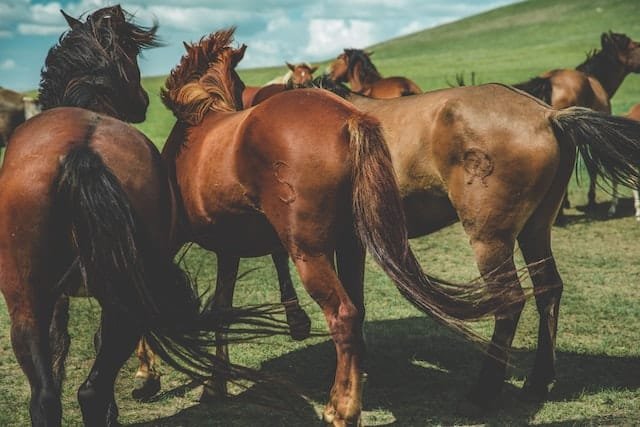Do Horses Have a Bone in their Tail? Quick answer: Yes! In fact, they have more than one.
The bones in a horse’s tail are a continuation of the vertebrae that start at the top of the horse’s neck. A horse can have between 15 and 22 vertebrae in its tail depending on the tail’s length.
If you’re interested in knowing more about how the tail fits into the horse’s skeletal structure and the various uses of the tail, keep reading!
Key Parts of a Horse’s Skeletal Structure
The horse’s skeleton can be divided into four main subgroups:
- The head
- The neck, spine and tail
- The ribs
- The legs
The head is mainly composed of the skull and the jaw. A horse has a heavy head and it helps the horse balance its body whenever the horse moves.
The longest sequence of bones is the horse’s vertebrae. These are divided into 3 parts: the neck, the spine, and the tail. A horse has 7 vertebrae in the neck, 29 in the spine, and between 1 and 22 in the tail.
The bones of the hind legs are connected to the end of the spinal vertebrae at the hip joint. The bones of the front legs are connected to the upper end of the spinal vertebrae by the shoulder blade, shoulder joint and sternum.
What is the function of a horse’s skeletal system?
The key function of a horse’s skeletal system is to support the horse’s body. The skeleton also protects vital organs, such as the brain and heart. Additionally, the bones act as levers that help the horse move its muscles.
The bones of the horse’s skeleton are connected by joints. Joints allow movement between bones. There are three main types of joints in a horse’s skeleton:
- The ball and socket joint is found in the hip and shoulder. This type of joint allows a greater range of motion.
- The hinge joint is found in the knee, elbow and jaw. This type of joint allows for back-and-forth motion.
- The pivot joint is found in the neck. This type of joint allows the head to turn side-to-side.
The cartilage and ligaments help to hold the bones together at the joints. The cartilage is a type of connective tissue that cushions the ends of the bones. Ligaments are like strong ropes that connect one bone to another.
The muscles are connected to the bones by tendons. The tendons act like pulleys, moving the bone when the muscle contracts.
Do Horses Have a Bone In Their Tail?
Yes. As we’ve seen above, the bones in a horse’s tail are a continuation of the vertebrae and follow the vertebrae of the neck and spine.
A horse has between 15 and 22 tail vertebrae.

The horse’s tail is made up of two main parts: the dock and the hair. The dock is the fleshy part of the tail that is attached to the horse’s body. The hair grows from the dock.
The bones in the horse’s tail are connected by ligaments and muscles. The muscles help the horse move its tail. The ligaments help to keep the bones in place.
What Does a Horse Use Its Tail for?
The key function of a horse’s tail is to help the horse keep its balance. Even though the tail is much lighter than the rest of the horse’s body, the heavy head in front and the swishing tail in the back help the horse maintain its balance.
The tail is also used to communicate with other horses. It can also be a window into the horse’s state of mind. A tail that is held high usually means that the horse is feeling alert and ready to move. A tail that is swishing back and forth usually means that the horse is angry, afraid, or highly displeased.
Finally, a very use of the horse’s tail is also used to swat away flies and other insects. The horse uses its tail like a fly swatter to keep pesky bugs away from its body. And it can be very precise about it too.
The Tail End of The Article …
So there you have it. The easy answer to the question – Do Horses Have a Bone in their Tail? – is a Yes. The bones in the tail are an extension of the vertebrae and play an important role in the horse’s use of the tail, which is to maintain its balance, communicate with others and swat annoying insects.


